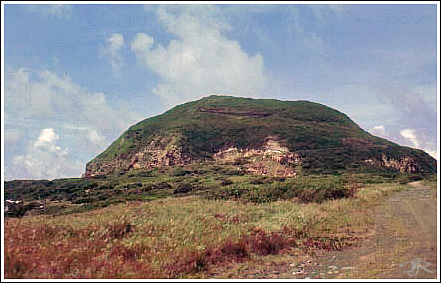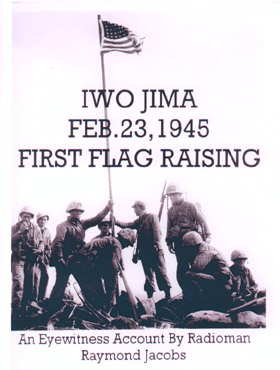
On February
22, 2004, we at World War II Stories -- In Their Own
Words received a brief message via our e-mail
from a Mr. Raymond Jacobs. Mr. Jacobs offered to forward to
us a copy of an essay that he had just completed regarding
events that occured on February 23, 1945 atop Mt. Suribachi
on the island of Iwo Jima.
The event
mentioned in this essay is the historic
1st
Flag Raising. Even though this event was overshadowed by
the famous 2nd Flag Raising that caught worldwide attention
when Mr. Joe Rosenthal caught this moment in time on film,
recognition for the original flag raising was slow to
come.
To this day,
Mr. Raymond Jacobs insists that his presence on the patrol
that walked, climbed, and crawled up Mt. Suribachi during
the intense first few days of battle for the "black pearl of
the Pacific" has yet to be recognized.
Why?
We received a
mailing a few days ago and the contents of that mailing from
Mr. Jacobs is presented in it's entirity below.
We have read
and re-read the accounts as they are portrayed by Mr. Jacobs
and have studied the images.
We have made
up our mind as to what this material represents.
We suggest
that you do the same.
Mr. Jacobs
accounts and stark photograph images tell a very important
story.
We are honored
to add Mr. Jacobs accounts to our web pages.
the
Webmaster
Iwo Jima
Feb. 23,
1945
First Flag
Raising
An Eyewitness
Account By Radioman Raymond Jacobs
On February
23, 1945 the first American flag was raised on Mt.
Suribachi, Iwo Jima, by a combat patrol from E Company, 2nd
Battalion, 28th Marines led by 1st Lieutenant Harold
Shrier.
Today, almost
60 years after the event,inaccurate information continues to
be circulated about the identity of the Marines and Corpsmen
who took part in the events that day on
Suribachi.
The historical
record should be accurate and beyond question. At the time
we were too absorbed with the enemy for formal introductions
and gathering names for the record or photo captions was not
a priority. In this essay I will attempt to correct some of
the past inaccuracies.
I was the
radioman who accompanied that patrol during the climb up
Suribachi. I was with the patrol when the first flag was
raised and when we put down the Japanese counter attack and
secured the top of Suribachi.
In proof of my
presence with Lt Shrier's patrol I will present clear and
unambiguous evidence from two independent
sources.
First. News
stories published in the United States just after the 1st
flag raising. Stories written on Iwo Jima by civilian
reporters representing major newspapers and Associated
Press. Reporters who climbed Mt. Suribachi and there
interviewed me and other Marines from Shrier's patrol
shortly after the mountain was secured.
Next, the
photographic record of Lt. Shriers patrol shot by USMC
Combat Photographer Sgt Lou Lowery. Sgt Lowery's pictures
clearly show me, in my role as radioman,as an integral part
of Shrier's patrol.
I will explain
how I, the F Company radioman, came to be the radioman with
Lt. Shrier's E Company patrol.
I will also
try to shed some light on the decades long errors in
identifying the personnel pictured in Sgt. Lowery's
photographs of the first flag raising.
In describing
the personnel and events of February 23,1945 I draw on what
I saw that day and on the material supplied by two
independent and unimpeachable sources.
Raymond Jacobs
[Signature and date]
01/09/04
In The
Beginning..

Captain Arthur
Naylor, C.O. F Company,2nd Battalion, 28
Marines.
Early morning
on Friday, Feb.23, 1945 Captain Naylor called Sgt. Sherman
Watson to the CP.He told Sgt. Watson to take a small
reconnaissance patrol to the top of Mt. Suribachi to look
for enemy troops and positions in and around the top of the
crater.
Sgt. Sherman
Watson was one of the most experienced NCO's in F Company.He
was a squad leader in our 3rd platoon. Watson selected three
trusted friends from his squad, Corporals White and
Mercer,and a BARman, PFC Louis Charlo.
They moved
cautiously up the steep slope of Suribachi and after a look
around at the crater rim they fell, slid and climbed down
returning to F Co. CPO.
Sgt. Watson
reported to Captain Naylor that they had not seen any
Japanese saying they must be dug in because there were
emplacements scattered around the crater. Naylor sent
Watson's patrol back to their platoon area and then phoned
2nd Battalion C.O. , Lt. Colonel Chandler Johnson,to pass on
Watson's report.
The Order To
Take Suribachi
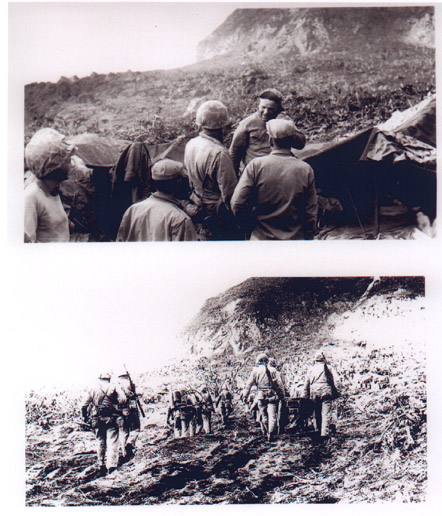
Lt. Colonel
Chandler, Johnson, CO 2nd Battalion, 28th Marines (facing
camera with phone) is pictured talking to Lt. Harold Shrier
after receiving the report from Capt. Naylor. Johnson wanted
a combat patrol from E Company to attack and secure the top
of Mt Suribachi.E Company CO Capt. Dave Severance gave
command of the patrol to his Executive Officer, Lt. Shrier.
They selected the 3rd platoon of F Company and added other
company personnel to strengthen the patrol. Johnson told
Shrier he wanted him to attack and take the top of
Suribachi. He then handed Shrier an American flag and told
him to take it with him.
I Am Assigned
To E Company Patrol.
At about this
time,while Lt. Shrier's patrol moved toward F Company lines,
the word was passed that there was a call for me on the
company phone at our CP.The phone call was an order from
battalion telling me that a patrol from E Company would soon
be passing through F Company lines. I was to turn on my
radio. .check in with battalion. .and wait for the E Company
patrol. When I saw the patrol I was to report to the patrol
leader Lt. Shrier and accompany him up Suribachi to provide
radio communication between the patrol and
battalion.
When the
patrol appeared I made contact with Lt Shrier and repeated
my orders.He told me to fall in and said let's
go.
As I recall,
the order phoned from battalion was given to me by the
battalion communication sergeant.He had been our radio
instructor during training at Camp Tarawa. It was also
custom and practice that battalion orders and instructions
directed at company level radiomen were relayed by the same
battalion communication sergeant.
Company radios
had been shut down since the previous afternoon. Battalion
linemen had run in telephone lines to connect our CP with
battalion. Radio reception and transmission was spotty in
the broken terrain on Iwo. Our radios were used when we were
on the move or when land lines were impractical. Phone lines
were preferred in fixed positions and our CP had been in the
same location since tha day before. Noisy night time radio
traffic could be heard at some distance even when
muted.
Up
Suribachi
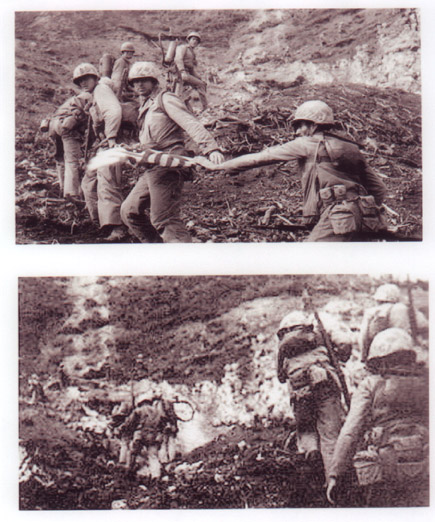
The patrol
begins to climb. The sides of Suribachi were very steep.The
ground we were climbing had been chewed and churned by
bombing, naval gunfire and our own artillery.
The flame
thrower man at the head of the column is Charles Lindberg.
Flamethrower behind Lindberg is identified as Pvt. Robert
Goode.
2nd from the
bottom is Lt. Shrier. Reaching for the flag is Pfc. Manuel
Panizo
The patrol
continues to climb. The climb was so steep and the ground so
broken that at times we were crawling on hands and
knees.
Taking
Suribachi's Highest Point
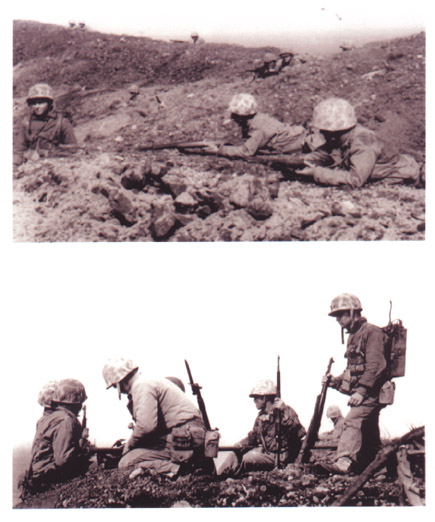
We reach the
top of Suribachi and move quickly along the rim. This is the
inner edge of the top of Suribachi's volcanic
crater.
Lt Shrier
spread the patrol around the inner rim of the crater in a
defensive perimeter facing inward toward the center of the
crater. I am in the left of the picture moving along the rim
toward higher ground where I see several Marines pulling a
piece of water pipe from the ground.
The Flag And
The Water Pipe
The pipe is of
Japanese origin probably to carry water to their defensive
positions around the crater.
The pipe is
holed in several places. Perhaps from shrapnel or rock
fragments. Cord is pulled through the holes and the flag is
secured.
Tying the flag
to the pipe.. L to R Pit Sgt Thomas, Lt Shrier, Cpl
Lindberg, Sgt Hansen (top of helmet), Unknown(with rifle),
Pfc Ray Jacobs.
I have
contacted 8 E Company survivors of the patrol sending them
pictures of the unknown Marine. No one was able to identify
the unknown person from this and other pictures taken by
Sgt. Lowery.
Preparing To
Raise The Flag
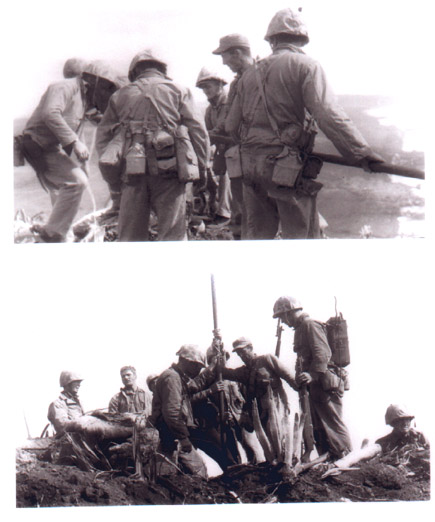
Lt. Shrier's
command group has moved to the highest point on Suribachi's
crater preparing to push the flag pole into the
ground.
Cpl Charles
Lindberg (on the left) is kicking at the ground to clear a
hole in the earth for the flag pole.
To the right
of Lindberg, the man carrying the large canvas pouches under
each arm,is PhM2c John Bradley. Bradley is seen in several
of Lowery's photographs but not acknowledged in the official
record.
Sgts. Thomas
and Hansen are to the right of Bradley. Then we see the
still unknown Marine with the double straps across his
back.
The Pole Is
Up
The pole is
jammed into the ground but is still unsteady.We take turns
pushing the pole deeper and kicking dirt and jamming rocks
around the base trying to secure the pole.
As you can see
the ground here has been torn up by bombing and artillery.
This was typical of the sides and top of
Suribachi
Our colors
are up.... snapping and waving in the
breeze.
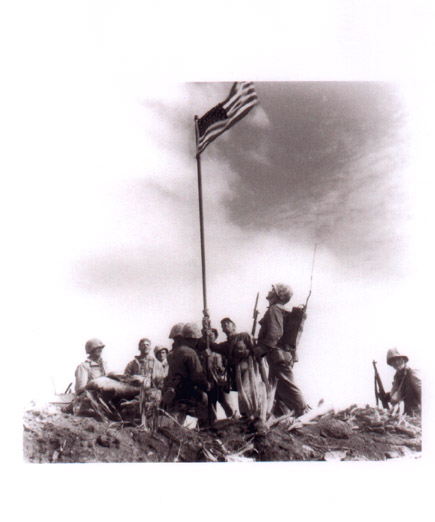
Just moments
after the flag was raised we heard a roar from down below on
the island.
Marines on the
ground, still engaged in combat, raised a spontaneous yell
when they saw the flag. Screaming and cheering so loud and
prolonged that we could hear it quite clearly on top of
Suribachi.
The boats on
the beach and the ships at sea joined in blowing horns and
whistles.
The
celebration went on for many minutes. It was a highly
emotional, strongly patriotic moment for all of
us.
Shrier Talks
To Johnson And The Enemy Responds
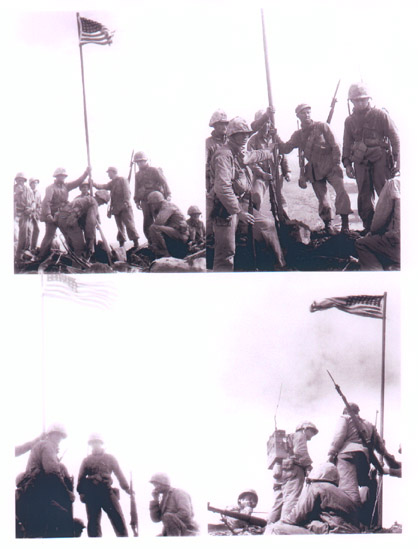
Shortly after
the flag was raised I received a radio call from battalion
asking for Lt. Shrier. The Lieutenant crossed over to me and
took the handset.
It was Lt.
Colonel Johnson.Piecing together one side of a two way
conversation, Colonel Johnson was congratulating Shrier on
the flag raising. Shrier made a brief report on conditions
at the top and ended the transmission.
Moments later
I noticed motion below and to my left. Looking over I saw a
Japanese soldier dressed in a field brown uniform running
out from behind a mound of earth on a lower part of the
crater rim.
He slapped the
grenade on his helmet and made a quick overhand throw. He
then spun around disappearing back behind the
mound.
The grenade
arced through the air in our direction but fell short of our
group. It exploded with a loud bang.A lot of noise but
fortunately no one was injured.
The exploding
grenade acted as a signal to the enemy dug in and hidden in
caves around the perimeter of the crater......
We Put Down
The Counterattack
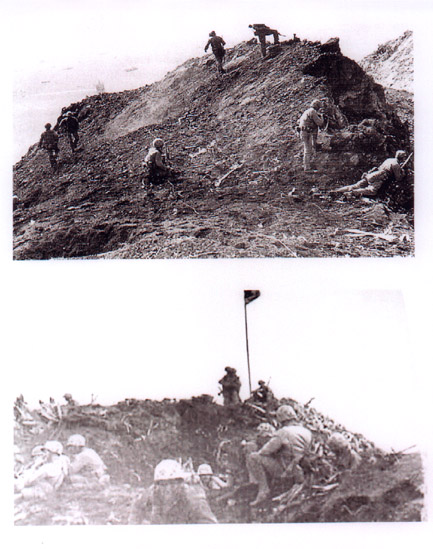
The Japanese,
apparently enraged by the sight of our colors, hit us with
rifle fire and a barrage of grenades. We responded with
flame throwers, grenades, BAR and rifle fire. I remember
seeing individual Marines and fire teams running toward the
caves firing as they ran. We burned and blasted caves on
both sides of the crater rim and soon it was over. Intense
but brief with Japanese resistance buried.
The only
casualty on our side was cameraman, Sgt Lou Lowery. He fell
over backwards trying to avoid a grenade and picked up some
bumps and bruises in a 20 or 30 yard slide down a steep
sloop over Suribachi's side. His camera was smashed but his
film undamaged.
This may be
the last picture Sgt. Lowery shot before his
fall.
Lt. Shrier and
I had moved from the crest of the crater to a position off
of the skyline. Shrier controlled his counterattack from
this position. From here he made several radio reports to
Lt. Col. Johnson at battalion CP including the message that
the Japanese attack had been put down and telling the
Colonel that Suribachi's top was now secure.
In this
picture by Sgt. Louis Burmeister, Shrier is to the right
with his back to the camera. My helmet, back and radio are
just above his left arm.
At one point
Col. Johnson asked Shrier if it would be all right for a
group of reporters and cameramen to come up to our
position.The Lieutenant approved.
Reporters
Climb Suribachi...Interview Marines
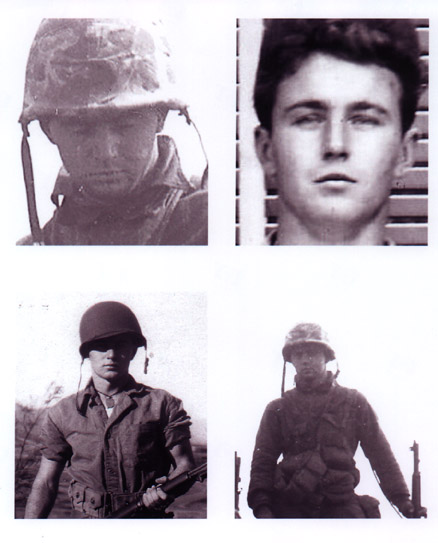
A short time
later I saw a group of people climbing toward us on the
steep island side of Suribachi. They were the reporters and
cameramen approved by Lt. Shrier. SF Examiner camerman Joe
Rosenthal was with this group. Later that day he shot the
famous picture of the second flag raising on Mt.
Suribachi.
The news
people climbed Suribachi looking for the story of the
Marines involved in the flag raising. An event which had
brought on a spontaneous roar of cheering from Marines
fighting on Iwo.
When the
reporters reached the top they found patrol Marines sprawled
on the ground around the crater rim. They spread out and
began interviewing us.
I was
approached by two reporters. Each asked the same questions
...name, rank, home town address and where were you when the
flag went up?
Using
facilities provided by the Navy the stories gathered by
these reporters were radioed back to the United
States.
On the
opposite page is a copy of the front page of the Los Angeles
Herald-Express published on February 24,1945. The picture
and quotes were obtained when reporters interviewed my
mother in our home in Los Angeles.
Similar
pictures and stories appeared as front page stories on the
same day in the Los Angeles Times.
News Reports
From Iwo Jima Place Me With Lt. Shrier's
Patrol.
Click on
above image for larger view.
The newspaper
clippings on the opposite page appeared over the next few
days in the Los Angeles Herald-Express and the Los Angeles
Times. Reporters from the papers went to my home,interviewed
my mother and took the picture of her you see
here.
Please note
the specific language of the news stories from Iwo Jima.
Clear, precise language from reporters on Mt. Suribachi
placing me with Lt. Shriers patrol during the first flag
raising.
"PFC Raymond
Jacobs of the Twenty-eigth Marines was revealed...as being a
member of the patrol of 14 leathernecks who proudly raised
the American flag on Mount Suribachi...yesterday". "The flag
raising unit was led by Lieut. Harold G. Shrier..."
.
"Young
Jacobs...was in the party that raised the American flag atop
Mount Suribachi. "
"Marine
Private Raymond Jacobs duplicated the charging tactics he
learned (in football) when his 14 man patrol charged
up..Suribachi on Iwo Jima to unfurl the American
flag".
Relieved.
It was close
to noon when I received the word that I was relieved and
should return to my unit, F Company. I reported to Lt.
Shrier then started the long slip and slide down the steep
flank of Suribachi.
I had been
with Shrier's E Company patrol for just over two hours and
now I was leaving it as abruptly I had joined it. It's
ironic that for this one brief, noteworthy moment in Marine
Corps history we had worked so closely together and yet I
didn't know any of members of the patrol and they didn't
know me.
Comparing Sgt. Lou Lowery's
Pictures
In the
introductory page of this presentation I said that I would
provide two independent sources to demonstrate that I was in
fact the radioman with the Shrier patrol. On the pages that
follow I will present that second source.The photographs of
Sgt. Lou Lowery.
I have cropped
and enlarged the facial features of the radioman in the
pictures shot by Sgt. Lou Lowery on Suribachi at the time of
the first flag raising. Pictures which clearly depict me
carrying out my assignment as radioman for Shrier's
patrol.
I have added
cropped and enlarged close-ups of pictures of me taken for
the most part in the year before Iwo Jima. These pictures
are from a family album collected by my mother.
In the
following pages the Lowery photo's will be displayed side by
side with those pictures from my family album to provide an
objective comparison.
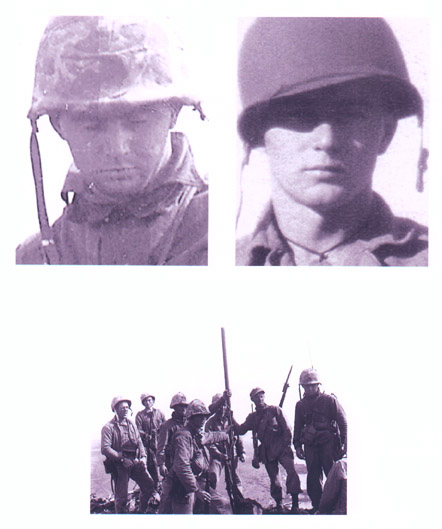
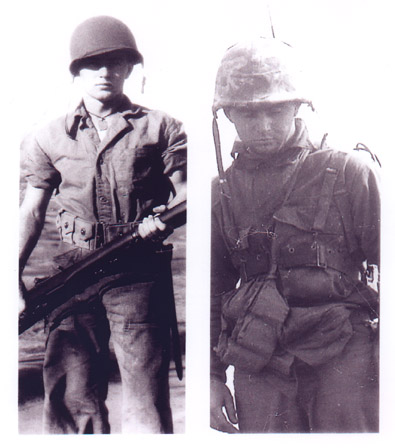
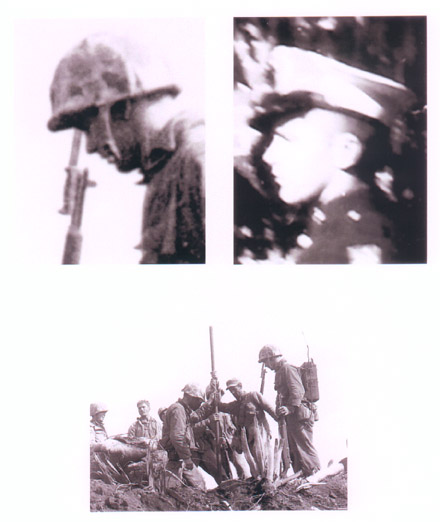
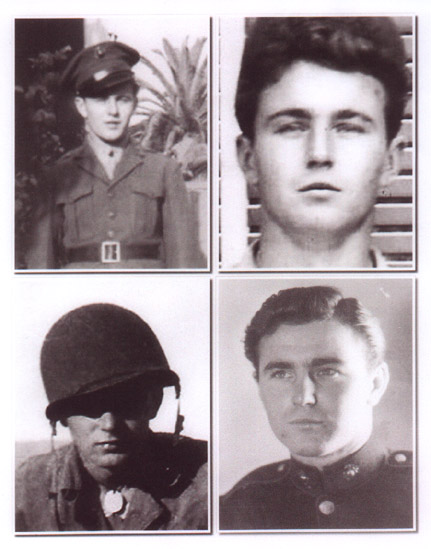
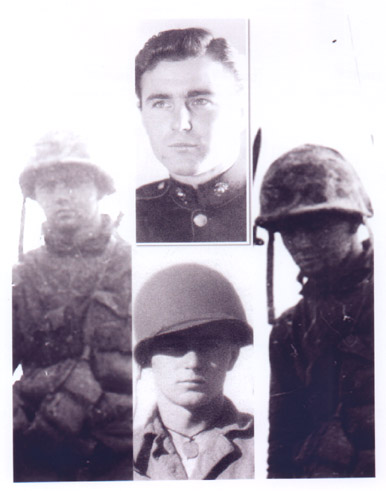
What's Wrong With This
Picture??
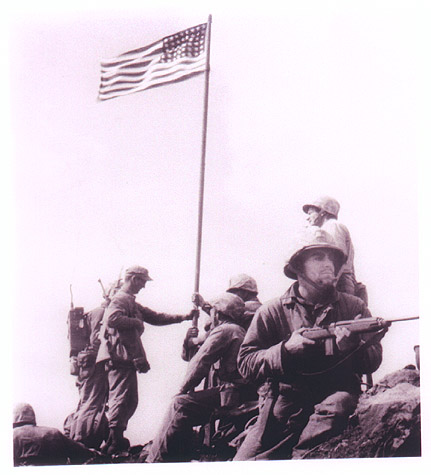
This Lowery
picture is the most widely circulated and recognized
photograph of the first flag raising on Iwo
Jima.
Unfortunately,
almost 60 years after the flag raising, the captioning
information widely distributed with this picture is
inaccurate and incomplete.
As recently as
this year information handed out to the general public has
incorrectly identified the Marines around the flag pole
as...
Left
to Right..
Sgt. Henry
Hansen (in cloth cap), PEC Louis Charlo (lower hand on flag
pole), Plt Sgt. Ernest Thomas (sitting with back to camera),
Lt. Harold Shrier (helmet above Sgt. Thomas), Pfc James
Michels (with carbine), Cpl Charles Lindberg (standing above
Michels).
Here is the
short list of errors in that caption.
1. No serious
effort to identify the radioman.
2. Pfc Louis
Charlo was not a member of Shrier's patroL The person
identified as Charlo is still unknown but it is definitely
not Louis Charlo. (more later).
3. The Marine
usually identified as Lt. Shrier is not Lt. Shrier. That
person is PhM2c John Bradley.
4. In this
picture Lt. Shrier can be found kneeling on the ground
behind my legs. When this picture was taken he was next to
me using the radio.
The captioning
information should read... Left to Right...
Pfc James
Robeson (lower left corner), Lt. Harold Shrier (sitting
behind my legs), Pfc Raymond Jacobs, Sgt. Henry Hansen
(cloth cap), Unknown (lower hand on pole), Sgt Ernest Thomas
(back to camera), Phm2c John Bradley (helmet above Thomas),
Pfc James Michels (with carbine), Cpl Charles Lindberg
(above Michels).
The
Historical Record Should Be Accurate
And Beyond
Question

This is the
reverse angle of the previous, more familiar, picture. From
this angle we see an additional Marine but we also get a
clear look at the faces of the people around the flag pole
and thus a more accurate identification of the people
actually present.
The caption for
this picture should read...left to right...
Cpl Charles
Lindberg, Sgt. Howard Snyder (the new face), PhM2c John
Bradley, Sgt. Ernest Thomas, Unknown, Sgt Henry Hansen,in
cloth cap) PFC Raymond Jacobs(radioman), Lt. Harold Shrier
(kneeling), PFC James Robeson.
This picture
corrects many past errors and misidentifications. The proof
is in Lowery's pictures.
John Bradley
was there but not acknowledged.
I was there
but not acknowledged.
There is one
person still unknown. **
Louis Charlo
was not there (see the next page).
Lt. Shrier was
not holding the flag pole as credited in much of the
captioning material circulated with the previous picture but
was where he is pictured in this photo...kneeling in front
of me using my radio. He was one of those who earlier had
actually raised the flag but, unfortunately, that action was
not photographed.
**I sent
pictures of the unknown Marine to 8 survivors of the 3rd
platoon patrol. No one identified him. Charles Lindberg
suggested it might be Phil Ward but could not confirm
it.
Looking For
Louis Charlo
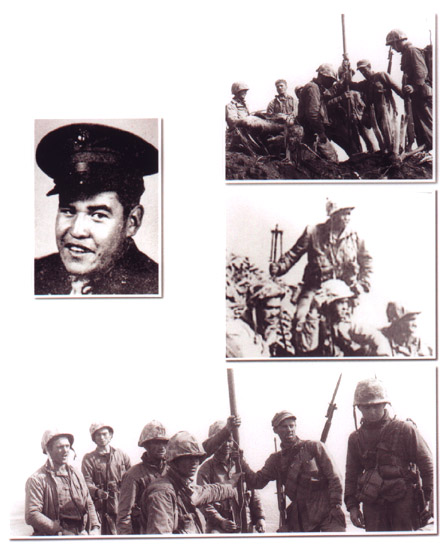
Louis Charlo
was a 'Good Marine' in the very best sense of that phrase.
He was good with his weapon, a BAR, agressive in using it
and intensely loyal to his fellow Marines.
He gave his
last full measure to the Corps on Iwo Jima.
Examine the
pictures of Louis Charlo on the opposite page. His facial
features are distinctive. Yet you will not find him in the
two pictures here or in any of the other Lowery pictures of
the Shrier patrol because, the official record not with
standing, he was not with Shrier's patrol.
I knew Louis
Charlo. We were in the same company. Had trained together
for months and been together on liberty at the F Company
hangout in L.A. more times than I can remember. We were not
close buddies but we were familiar to each
other.
That's why I
can say with confidence that Louis Charlo was not with Lt.
Shrier's patrol at any time from the climb up Suribachi
through the flag raising and securing of the mountain
top.
He
was,however, one of Sgt. Watson's 4 man F Company patrol
which made the early morning reconnaissance patrol to the
top of Suribachi. I witnessed Watson's patrol climbing up
Suribachi and coming down.
Charlo was
mistakenly placed in the Shrier patrol when then Senator
Mike Mansfield of Montana confused the news stories of
Watson's patrol with that of Shrier's. Mansfield then
proudly announced on the Senate floor and to the national
press that a constituent of his (Charlo) had helped raise
the flag on Iwo Jima.
Mansfield's
mistake became part of the official record and lives on to
this day.
Correcting
Mansfield's mistake would do nothing to diminish Louis
Charlo's reputation as a Good Marine'. Correcting the
official record is simply the right thing to do.
In the
introduction to this essay I said that I would prove my
presence with Lieutenant Shrier's E Company patrol when we
climbed Mt. Suribachi and raised the first American
Flag.
I also said I
would call attention to decades old errors in the official
story of the people involved in the first flag
raising.
In support of
my presence with the Shrier patrol I have presented two
independent and unimpeachable sources.
The accounts
of reporters who joined us that day shortly after Suribachi
was secured were published in Los Angeles newspapers the
next day.They clearly and specifically place me with Lt.
Shrier's patrol at the time of the first flag
raising.
USMC Combat
Photographer Sergeant Lou Lowery took over 30 photographs of
Shrier's patrol. In pairing his pictures with personal
photographs the resemblance and connection is obvious and
unmistakable. I was the radioman in Lowery s
pictures.
Again, using
Sgt. Lowery's photographs, it is clear that the official
record of those present at the first flag raising is in
error. The record credits people who were not there and
ignores others who were there.
The Marines
and Corpsmen who took part in that event should now,at long
last, be correctly identified and their roles accurately
described .
This time next
year we will be approaching the 60th anniversary of the flag
raisings on Iwo Jima.What better time than now to update and
correct the official record of first flag raising and of the
personnel who took part.
Raymond
Jacobs
P.O. Box 10970
South Lake Tahoe, CA. 96158
Ph# (530) 573-0285
If you would
like to e-mail
Mr. Raymond Jacobs, please do so
by clicking on Mr. Jacobs signature below:

[signature]
Date:
02/04
No long ago, we
received a copy of a letter written to Mr. Jacobs. The
letter was from the firm of Ebert & Associates Inc. from
Mr. James I. Ebert, PhD, Certified Photogrammetrist (ASPRS),
Fellow, American Academy of Forensic Sciences.
The letter
addresses Mr. Ebert's conclusions with regards to the
photographic evidence that Mr. Ray Jacobs had presented to
him.
A copy of that
letter is attached:
Iwo
Jima: The First Flag Raising:
Conclusions
There are many
web sites devoted to the United States Marine Corps. Below
are some of the more interesting ones that give accounts of
the 5th Marine Division on Iwo Jima:
Iwo
Jima (Flags of Our Fathers)
Gunny
G's Globe and Anchor - Sites &
Forums
5th
Marine Division on Iwo Jima
World
War II - Battle for Iwo Jima
Iwo
Jima Flag Raising on Mt. Suribachi
Original story
received in the mail on 12 March 2004.
Story added
and modified on 16 March 2004.
We, at the
World War II Stories - In Their Own
Words web site wish to offer to Mr. Raymond
Jacobs our most profound THANK YOU for the account of his
personal experiences -- during World War II and especially
for allowing us to share those memories. We will always be
grateful for this fine gentleman's contributions to the war
effort and to the countless other men and women who put
forth their "finest hour".
|
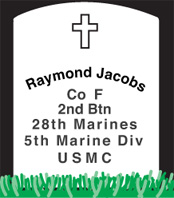
|

Taps for
Mr.
Raymond Jacobs
29 January 2008
F Co, 2nd Btn, 28th Marines, 5th Marine Div
World War II Veteran
United States Marine Corps
|
Note: To view
images taken by the web master on World War II Stories -- In
Their Own Words during his year on Iwo Jima, please click on
the following link to my World War II Stories Photo
Album:
WW
II Stories: Iwo Jima Photo Album
1965-1966
Did YOU serve on Iwo Jima?
Did you know that
there is a group of veterans who have gotten together to
form an association of servicemen, no matter what branch of
service, who served at one time or another starting at the
invasion of the island on February 19, 1945 and continuing
until the island was eventually returned to the Japanese in
1968?
Iwo
Veterans Organization
We, at the
Iwo
Jima Memoirs web site wish to offer to Mr. Joseph Pellam
our most profound THANK YOU for his poignant story of his
personal experiences -- during his tour of Iwo Jima and
especially for allowing us to share those
memories.
Original story transcribed on 16 February 2005
Did YOU serve on
Iwo Jima?
Do YOU have
a story to tell?
Do YOU have a picture or pictures
that tells a story?
Contact me, Joe
Richard and I can help by adding YOUR story to my site
devoted to veterans who served on Iwo Jima.
Check out my
other web site on World War II. Click on the Image
Below:

If You Would
Like to E-mail us, Click on the Image Below:

©
Copyright 2001-2008
Iwo Jima Stories
All Rights Reserved
Updated on
14 April 2008...1558:05 CST
| 
